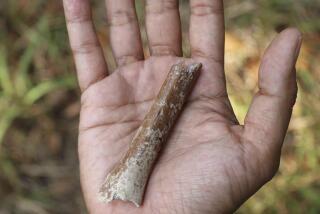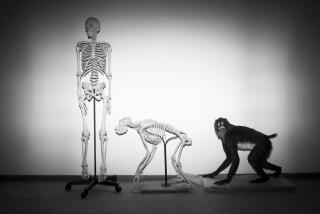Hominid fossils may shake up the human family tree
After examining the fossils of two hominids that lived nearly 2 million years ago, anthropologists said that the anatomical features of the adult female and young male strongly suggest they could be members of a species that was a direct ancestor of modern humans.
In a series of reports published in Friday’s edition of the journal Science, the researchers describe the Australopithecus sediba specimens as having a curious mix of primitive and modern features that could prompt experts to redraw the human family tree.
For instance, they had hands capable of using tools but still strong enough to grasp tree branches. They had a more curved pelvis that would have theoretically accommodated a bigger brain on its way through the birth canal, even though they still had small heads.
Perhaps the mosaic of features indicates that A. sediba was at an evolutionary transition point between the tree-climbing australopithecines and upright-walking, often tool-using members of the genus Homo, which includes Homo sapiens, the single surviving member species.
“It doesn’t change the way we look at Australopithecus overall, but it does suggest sediba might be a good ancestor for the genus Homo,” said Steven Churchill, a paleoanthropologist at Duke University who co-wrote several of the studies.
The fossil remains were discovered in 2008 by Lee Berger, whose then-9-year-old son had accompanied him to a dig site in South Africa. Berger’s son had been chasing their dog, Tau, when he stumbled across a rock and immediately saw that it was a fossil. He took it back to his father, who recognized a collarbone in the block of stone.
Paleoanthropologists soon found the rest of the remains, and surmised that the two must have fallen down a hole into a cave and died there. Their bodies were soon surrounded in cave sediment, preserving them to an unusual degree.
A. sediba was soon recognized as a new species and classified with the australopithecines. (The most famous member of this group is Australopithecus afarensis, better known as Lucy, who lived 3 million years ago.) But the new studies indicate that A. sediba had begun to develop more human-like qualities.
Researched mapped the surface inside a skull to get a picture of what the brain looked like. Though relatively small — 420 cubic centimeters in volume, only one-third to one-quarter the size of a modern human brain — and still sharing bumps and furrows characteristic of other Australopithecus species, the brain showed changes in the frontal lobe reminiscent of modern humans’ front-loaded craniums.
The examination of the pelvises revealed more surprises. The A. sediba pelvis was round and bowl-shaped, rather like those of people. Scientists had thought that modern humans developed such a pelvis in part to allow large-brained babies to fit through the birth canal.
But, Churchill said, “a lot of the things which were thought to change because of bigger-brained babies are happening before bigger-brained babies came along.” This probably meant that two-footed travel was the stronger driving factor in pelvic evolution, he said.
The hand and foot studies added more mystery to the mix. Sediba had hands with wider finger pads and a very long thumb, both of which would have been useful for nimbly controlling and manipulating objects. Modified wrist bones would have allowed for hands better able to absorb the shocks of toolmaking. But the researchers also found that the hands had very strong flexor muscles, useful for gripping and climbing trees.
The feet, though they may have had an arch and Achilles tendon suitable for walking, also had a relatively small heel bone compared with that of modern humans. These were feet still suited to climbing as much as walking.
Such a mix of primitive and modern features led Berger and colleagues to suggest that A. sediba could be an ancestor to the genus Homo.
But the age of the fossils presents a problem. The researchers’ isotopic and magnetic dating showed the fossils were 1.977 million years old, about 300,000 years younger than a Homo habilis fossil that should have been their junior.
“Our team is not entirely convinced that it [the Homo habilis] really does represent the genus Homo. It could be a late-surviving australopith,” Churchill said. The researchers also questioned some of the dates for fossils that could call their theory into question.
The suggestion that A. sediba is the most recent common ancestor of all Homo species has been met with careful skepticism at best and acrimony at worst by scientists who were not part of the research team. Among other concerns are the way the team raised questions about the Homo habilis in order to support their theory.
“They’re going to have to make a stronger case,” said paleoanthropologist Donald Johanson of Arizona State University, who discovered Lucy. Johanson, a friend of Berger’s who has seen the fossils, said the only solution would be to look for more evidence as the anthropologists continue to dig.
“I know this is a terrible thing to say,” he said. “But we’d all like to [understand] the shape of the [human family] tree and the positions on the tree — and we really do need more fossils.”






